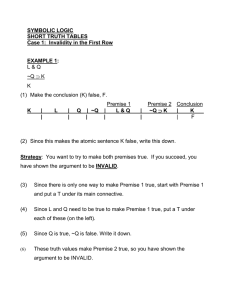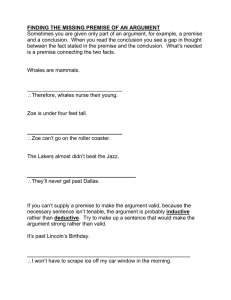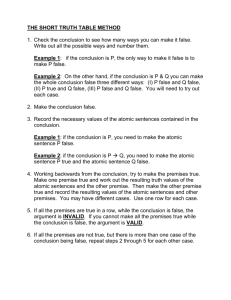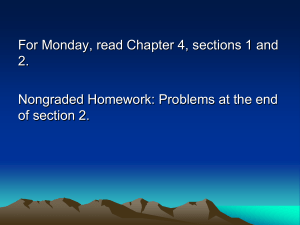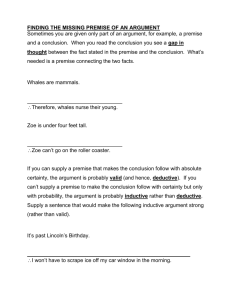The Short Truth Table Method: More Rows Needed To Show Invalid
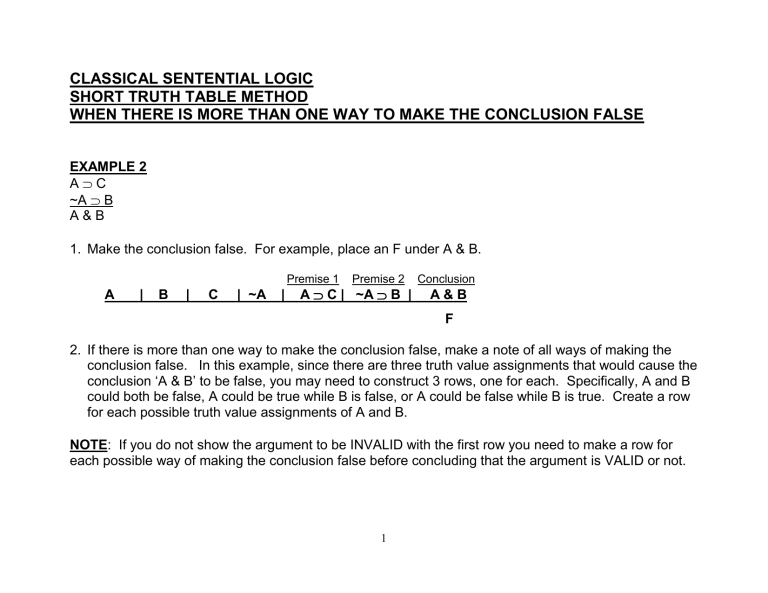
CLASSICAL SENTENTIAL LOGIC
SHORT TRUTH TABLE METHOD
WHEN THERE IS MORE THAN ONE WAY TO MAKE THE CONCLUSION FALSE
EXAMPLE 2
A
C
~A
B
A & B
1. Make the conclusion false. For example, place an F under A & B.
Premise 1 Premise 2 Conclusion
A | B | C | ~A | A
C | ~A
B | A & B
F
2. If there is more than one way to make the conclusion false, make a note of all ways of making the conclusion false. In this example, since there are three truth value assignments that would cause the conclusion ‘A & B’ to be false, you may need to construct 3 rows, one for each. Specifically, A and B could both be false, A could be true while B is false, or A could be false while B is true. Create a row for each possible truth value assignments of A and B.
NOTE : If you do not show the argument to be INVALID with the first row you need to make a row for each possible way of making the conclusion false before concluding that the argument is VALID or not.
1
Premise 1 Premise 2 Conclusion
A | B | C | ~A | A
C | ~A
B | A & B
F F
T F
F T
F
F
F
3. Look for which premise is hardest to make true, then write down T. In Example 2, since the ~A of
Premise 2 is true, the only way for the whole formula to be true is for B also to be true. Since it is impossible, in row one, for B to be T, Premise 2 cannot be true in that row and that row cannot show the argument to be invalid. However, there are other rows.
Premise 1 Premise 2 Conclusion
A | B | C | ~A | A
C | ~A
B | A & B
F F T F F
T F
T F
F
F
4. In the next row (containing another way to make the conclusion false), fill in any truth values you can based on the truth values of the atomic sentences. In Example 2, since A is true, ~A is F.
Premise 1 Premise 2 Conclusion
A | B | C | ~A | A
C | ~A
B | A & B
F F
T F
F T
T
F
F
T
F
F
F
2
5. In this row, try to make one of the premises T given the current truth value assignments. In Example
2, since ~A is false and B is F, Premise 2 is true. Write down the truth value (T) under that premise
(2).
6. If some compound sentences are blank, and you can fill them in, do so.
7. If there are no more premises, go to Step 8. If there are more premises, repeat steps 5-7 until you are done.
8. If all premises are true in this row, you have shown the argument to be INVALID . If you cannot make all premises true in this row and there are other rows, repeat Steps 4-8.
9. If you finish all rows without achieving all true premises and a false conclusion, you have shown the argument to be VALID .
3
